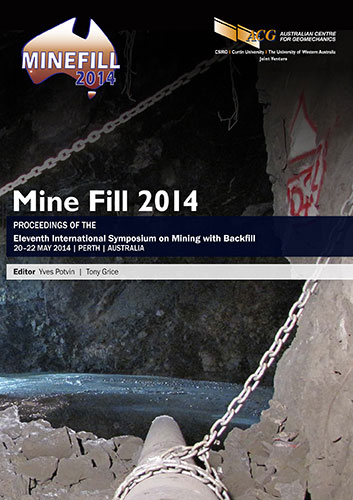Blast vibration monitoring in cemented paste backfill during its curing stage – a case study

|
Authors: Mohanty, B; Trivino, LF |
DOI https://doi.org/10.36487/ACG_rep/1404_40_Mohanty
Cite As:
Mohanty, B & Trivino, LF 2014, 'Blast vibration monitoring in cemented paste backfill during its curing stage – a case study', in Y Potvin & T Grice (eds), Mine Fill 2014: Proceedings of the Eleventh International Symposium on Mining with Backfill, Australian Centre for Geomechanics, Perth, pp. 493-501, https://doi.org/10.36487/ACG_rep/1404_40_Mohanty
Abstract:
An extensive seismic monitoring program was carried out at an underground mine as part of a comprehensive geotechnical study on the behaviour of cemented paste backfill (CPB) used as stope filling material, under a normal production blast environment. The ultimate goal of the study was to investigate potential liquefaction hazard of CPB due to seismic vibrations issuing from nearby blasting operations. The specific objectives of this phase of the investigation were to; (a) characterise the seismic response of both in situ rock and CPB in selected areas as it relates to normal blasting operation in the mine, (b) determine both amplitude and frequency characteristics of the vibrations issuing from both controlled and normal production blasts in the vicinity of backfilled stope, and (c) study the effect of curing time on the vibration characteristics in the backfill. Multiple vibrations sensors in the form of triaxial accelerometers were embedded in both in situ rock and adjacent backfill. The accelerometers employed in the backfill had a maximum amplitude range of 5-10 g and a frequency response of 1-5 kHz; the accelerometers in rock had a maximum range of either 500 or 1,000 g and a frequency range of 1-10 kHz. The range of distance employed from the blasts was 10-100 m. This paper details the changes in the blast vibration characteristics in CPB with curing time (up to 28 days) in terms of vibration amplitude, frequency content, and the changes in both P-wave velocity, and their implication on vibration loads from typical production blasts at the mine.
References:
Aref, K 1989, ‘A study of the geotechnical characteristics and liquefaction potential of paste backfill’, PhD thesis, McGill University.
Been, K, Brown, ET &Hepworth, N 2002, ‘Liquefaction potential of paste fill at Neves Corvo mine, Portugal’, Transactions of the Institutions of Mining and Metallurgy, April 2002, pp. A47-A58.
Grabinsky, M, Bawden, W, Simon, D & Thompson B 2008, ‘In situ properties of cemented paste backfill in an alimak stope’, Proceedings of the 61st Canadian Geotechnical Conference and the 9th Joint IAH-CNC/CGS Conference, Canadian Geotechnical Society, Richmond, pp. 790-6.
Grice, AG 1998, ‘Underground mining with backfill’, Proceedings of the 2nd Annual Summit – Mine Tailings Disposal Systems, pp. 234-9.
Johnson, JC, Williams, T & Pierce, P 2007, ‘The response of cemented backfill to dynamic loads from field observations and split Hopkinson pressure bar tests’, in FP Hassani and JF Archibald (eds), Proceedings of the 9th International Symposium on Mining with Backfill, Canadian Institute of Mining, Metallurgy and Petroleum, Westmount, on CD-ROM.
le Roux, K, Bawden, WF & Grabinsky, MF 2004, ‘Liquefaction analysis of early age cemented paste backfill’, Proceedings of the Eighth International Symposium on Mining with Backfill.
Mohanty, B, Yang, R, LeBlanc, M & Kelly, C 1995, ‘Dilution control and vibration studies at an underground mine’, Proceedings of the 25th Annual Conference on Explosives and Blasting Technique, International Society of Explosives Engineers, Cleveland, pp. 20-29.
Ouellet, J, Benzaazoua, M & Servant, S 1998, ‘Mechanical, mineralogical and chemical characterization of a paste backfill’, Proceedings of the 5th International Conference Tailings and Mine Waste, Balkema, Rotterdam, pp. 139-46.
Revell, M 2000, ‘Cannington backfill taking the pig out of paste’, Proceedings of the Paste Technology Seminar, pp. 1-12.
Saebimoghaddam, A 2010, ‘Liquefaction of early age cemented paste backfill’, PhD thesis, University of Toronto.
Studer, J & Kok, L 1980, ‘Blast-induced excess porewater pressure and liquefaction: Experience and application’, in GN Pande & OC Zienkiewicz, Proceedings of the International Symposium on Soils under Cyclic and Transient Loading, Balkema, Rotterdam, pp. 581-93.
© Copyright 2025, Australian Centre for Geomechanics (ACG), The University of Western Australia. All rights reserved.
View copyright/legal information
Please direct any queries or error reports to repository-acg@uwa.edu.au
View copyright/legal information
Please direct any queries or error reports to repository-acg@uwa.edu.au